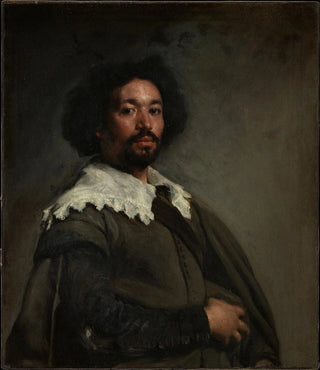Art print | Juan de Pareja - Diego Velázquez


View from behind

Frame (optional)
Juan de Pareja Art print - Diego Velázquez – Captivating Introduction
In the fascinating world of Baroque painting, the "Juan de Pareja" art print by Diego Velázquez stands out for its psychological depth and visual brilliance. Created in 1650, this iconic canvas captures not only the face of the painter's assistant but also the very essence of Velázquez's art. Through this portrait, the artist invites us to contemplate the gaze of Juan de Pareja, a man whose life was marked by servitude, but who, under Velázquez's brush, becomes a figure of striking dignity. This masterpiece embodies the fusion of realism and baroque, immersing us in an era when painting was a means of asserting social status and identity.
Style and uniqueness of the work
Velázquez's style in "Juan de Pareja" is a perfect example of his innovative approach to portraiture. The soft light illuminating Pareja's face creates a subtle contrast with the dark background, highlighting the delicate features and emotive expression of the model. The oil painting technique, mastered by Velázquez, allows for rich textures and nuanced colors that add an almost tactile dimension to the work. The artist manages to transcend mere representation to offer a true psychological introspection. Juan de Pareja's gaze, both thoughtful and penetrating, seems to question us, engaging us in a silent dialogue. This portrait is not limited to a static image but becomes an open window into the man's soul, revealing his thoughts and aspirations.
The artist and his influence
Diego Velázquez, born in 1599 in Seville, is one of the undisputed masters of Spanish painting. His artistic journey led him to the court of Philip IV, where he became the official painter. This status allowed him to explore a variety of themes, ranging from royal portraits to genre scenes, while developing a unique style that combines realism and expressiveness. Velázquez successfully influenced generations of artists, both in Spain and abroad. His innovative approach to portraiture, which emphasizes the psychology of subjects and mastery of light, paved the way for

Matte finish

View from behind

Frame (optional)
Juan de Pareja Art print - Diego Velázquez – Captivating Introduction
In the fascinating world of Baroque painting, the "Juan de Pareja" art print by Diego Velázquez stands out for its psychological depth and visual brilliance. Created in 1650, this iconic canvas captures not only the face of the painter's assistant but also the very essence of Velázquez's art. Through this portrait, the artist invites us to contemplate the gaze of Juan de Pareja, a man whose life was marked by servitude, but who, under Velázquez's brush, becomes a figure of striking dignity. This masterpiece embodies the fusion of realism and baroque, immersing us in an era when painting was a means of asserting social status and identity.
Style and uniqueness of the work
Velázquez's style in "Juan de Pareja" is a perfect example of his innovative approach to portraiture. The soft light illuminating Pareja's face creates a subtle contrast with the dark background, highlighting the delicate features and emotive expression of the model. The oil painting technique, mastered by Velázquez, allows for rich textures and nuanced colors that add an almost tactile dimension to the work. The artist manages to transcend mere representation to offer a true psychological introspection. Juan de Pareja's gaze, both thoughtful and penetrating, seems to question us, engaging us in a silent dialogue. This portrait is not limited to a static image but becomes an open window into the man's soul, revealing his thoughts and aspirations.
The artist and his influence
Diego Velázquez, born in 1599 in Seville, is one of the undisputed masters of Spanish painting. His artistic journey led him to the court of Philip IV, where he became the official painter. This status allowed him to explore a variety of themes, ranging from royal portraits to genre scenes, while developing a unique style that combines realism and expressiveness. Velázquez successfully influenced generations of artists, both in Spain and abroad. His innovative approach to portraiture, which emphasizes the psychology of subjects and mastery of light, paved the way for






